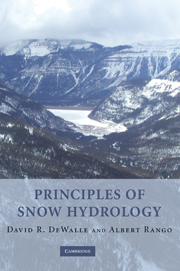Book contents
- Frontmatter
- Contents
- Preface
- 1 Introduction
- 2 Snow climatology and snow distribution
- 3 Snowpack condition
- 4 Ground-based snowfall and snowpack measurements
- 5 Remote sensing of the snowpack
- 6 Snowpack energy exchange: basic theory
- 7 Snowpack energy exchange: topographic and forest effects
- 8 Snowfall, snowpack, and meltwater chemistry
- 9 Snowmelt-runoff processes
- 10 Modelling snowmelt runoff
- 11 Snowmelt-Runoff Model (SRM)
- 12 Snowpack management and modifications
- Appendix A Physical constants
- Appendix B Potential solar irradiation theory
- Index
- Plate Section
- References
8 - Snowfall, snowpack, and meltwater chemistry
Published online by Cambridge University Press: 18 August 2009
- Frontmatter
- Contents
- Preface
- 1 Introduction
- 2 Snow climatology and snow distribution
- 3 Snowpack condition
- 4 Ground-based snowfall and snowpack measurements
- 5 Remote sensing of the snowpack
- 6 Snowpack energy exchange: basic theory
- 7 Snowpack energy exchange: topographic and forest effects
- 8 Snowfall, snowpack, and meltwater chemistry
- 9 Snowmelt-runoff processes
- 10 Modelling snowmelt runoff
- 11 Snowmelt-Runoff Model (SRM)
- 12 Snowpack management and modifications
- Appendix A Physical constants
- Appendix B Potential solar irradiation theory
- Index
- Plate Section
- References
Summary
Introduction
Biogeochemical cycling of nutrients and pollutants in the environment is significantly affected by the occurrence of snowfall and snowpacks. Snowpacks can be viewed as reservoirs of chemicals that, unlike substances dissolved in rainfall, can be largely stored for significant periods of time during winter until melting occurs. Snowpacks reflect the chemical nature of the original snowfall events or wet deposition that accumulated to create them as well as the dry deposition of chemicals occurring as aerosol droplets, particles, and gases in the atmosphere deposited on the snowpack surface during non-precipitation periods. Both naturally cycling chemicals and pollutants in the environment end up in the snowpack in this manner. Snowpack chemistry may also be affected by interactions with plant canopies during interception and the activity of organisms that find a home in the snow. Once melting or rain-on-snow events occur, chemicals are redistributed and released from the snowpack non-uniformly due to fractionation processes leading to relative enrichment of the initial liquid-water releases. In polluted environments, early spring fish kills have been attributed to effects of these initial concentrated acidic snowmelt-runoff events that caused toxic levels of dissolved aluminum to occur in streams. Studies have also shown that some ions are preferentially eluted or leached from the snowpack in different ratios than found in the snow itself. Stable isotope fractionation also occurs in snow during winter and can be used to study phase changes important in snow hydrology.
- Type
- Chapter
- Information
- Principles of Snow Hydrology , pp. 211 - 234Publisher: Cambridge University PressPrint publication year: 2008



